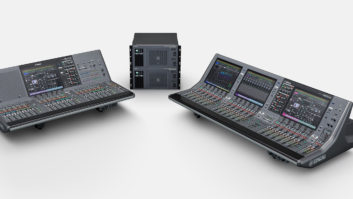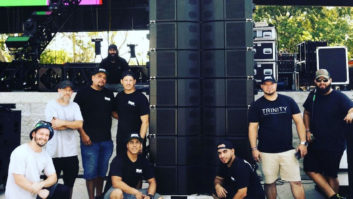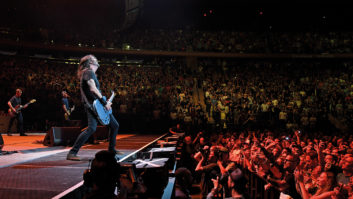LOS ANGELES, CA—Jean-Michel Jarre has performed for the largest crowds ever assembled, in Moscow (3.5 million) and Paris (2.5 million), both acknowledged by Guinness World Records. In 1986, he played to 1.5 million in Houston, yet in more than four decades of live performing, Jarre had never toured the United States before this year.
The past couple of years have seen something of a reinvigoration of Jarre’s career, beginning with the release of his two-part Electronica album, which brought him a Grammy nomination in the Dance/Electronic category. A third release, Oxygène 3, celebrated the fortieth anniversary of his breakout album, 1976’s Oxygène, which has sold an estimated 12 million copies.
Drawing on the material from his three latest projects, as well as some of the classics that have helped push his total sales above 80 million, Jarre’s Electronica World Tour arrived in early May for a nine-city jaunt beginning in Toronto and passing through Boston, New York City and Chicago before a final show in Los Angeles. The tour kicked off in the UK on October 4, 2016, racking up 40 shows across Europe before Christmas.
Rather than go to the expense of shipping a PA to the US, the tour instead used in-house systems or rented speaker boxes as needed, reports Alain Courieux, Jarre’s longtime front-of-house engineer. “In a venue like here, at the Microsoft Theater, or Radio City Music Hall, you have to take out the existing system and then put in yours. That costs a lot of money,” he says.
The tour did travel with its own control gear, however, including a pair of DiGiCo SD7 desks from Jarre’s usual production provider in France, Dushow. “We also brought a Meyer Sound Galileo. It has been really welcomed by the people in the venues,” he reports.
It has been interesting to compare the different tonal balances of the speaker systems, according to Cédric Courieux, the tour’s system engineer, Alain’s son and formerly a member of the L-Acoustics R&D team behind K1 and the K1 and SB28 subwoofers. Courieux, with Jarre since 2009, has had little previous exposure to some of the speakers provided on this tour, such as those from JBL—installed at LA’s Microsoft Theater—and Clair Brothers, he says.
Production providers on the U.S. tour included Solotech, Clearwing and Sound On Stage. Courieux also encountered Adamson, d&b audiotechnik and L-Acoustics K1 rigs, he reports.
“We have to EQ and tune differently every day to get the same tonal balance, in order for the front-of-house guy to work with the same mix. That’s really important; that’s part of the job,” he says.
Galileo was his choice, and its flexible outputs have been invaluable, he reports. “Here, for example, we are feeding the PA with AES (lines), but at another venue, where they had a Clair Brothers system, it was only analog.”

More than 160 inputs from Jean-Michel Jarre (center) and two bandmates went to the DiGiCo SD7 console at FOH.
Alain Courieux, wrangling more than 160 inputs from Jarre and his two band mates, who add acoustic and electronic percussion as well as keyboards to the mix, relies heavily on the DiGiCo desk’s dynamics, plus some outboard delays. “I don’t use a lot of EQ on the console; I’m doing the channel balance with the multiband compressors,” he says, adding, “I love the sound of the board.”
He’s been a DiGiCo fan since 2006: “I think I was the first to bring the DiGiCo to France, for the anniversary of Oxygène. It was one of the first times we used the D5.” Jarre also has an SD7 in his studio.
With so many analog synthesizers on stage, it’s important to maintain the dynamics, he continues. “When you are using a Moog Taurus, for example, you need a real console, not a toy, to get the real bottom of the synthesizer.”
With so many sequences generated out of Ableton Live, and other sound sources firing off on stage, it’s not surprising that much of the production, including lights and lasers, runs against timecode. “I use the timecode to recall the (DiGiCo) snapshots. Then I have my hands on the mix,” says Courieux.
Monitor engineer Vincent Mantz, a 13-year veteran with Jarre, feeds the three musicians and the technical crew via a Shure PSM 1000 in-ear system. To give the musicians a sense of the audience, he says, “I try to have six microphones, two Sennheiser shotguns on each side and two smaller mics in the middle. And I have one spare mix in case the front-of-house console crashes; it can save the show.”
Mantz, who uses a Waves SoundGrid server principally for the numerous delays he adds to the mixes, has taken his snapshot automation a step further. “I use OSC, Open Sound Control, the ‘new MIDI.’ You can drive the desk with an iPad,” he says. His custom iPad interface also streamlines communications. “I can speak with Jean-Michel only, or with all the crew; I did a few things so that it’s easier to work,” says Mantz.
DiGiCo
www.digico.biz







